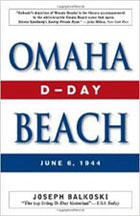| Plan a trip : |  |
 |
|
 |
Raymond S. HOBACK - 29th Division.
Bedford Boys Fallen - Raymond Samuel HOBACK never had a chance to reach 100 years old today. Instead, he sacrified his life for our freedom... Raymond may have made it out of his landing craft, but he never made it to shore. Others recall seeing his body in the water. Bedford also failed to make in on the beach. He was killed by an exploding 88mm shell. Their time in the battle could be measured in minutes... [American D-Day facebook] Read more...
[Posted: 2020-01-21 22:40:05]
Bedford Boys Fallen - Raymond Samuel HOBACK never had a chance to reach 100 years old today. Instead, he sacrified his life for our freedom... Raymond may have made it out of his landing craft, but he never made it to shore. Others recall seeing his body in the water. Bedford also failed to make in on the beach. He was killed by an exploding 88mm shell. Their time in the battle could be measured in minutes... [American D-Day facebook] Read more...
[Posted: 2020-01-21 22:40:05]
RIP - Robert GIGUERE - Navy.
It is with heavy heart we learn the passing of Mr. Robert GIGUERE, a veteran of D-Day (Normandy)... He was 93... Four days earlier, Giguere rode across the choppy English Channel toward the Normandy coast with the Sixth Naval Beach Battalion. When his carrier grounded on the beach, a Teller mine detonated from beneath and tore through the ship's hull, Killing several soldiers below deck... [American D-Day facebook] Read more...
[Posted: 2020-01-21 22:58:23]
It is with heavy heart we learn the passing of Mr. Robert GIGUERE, a veteran of D-Day (Normandy)... He was 93... Four days earlier, Giguere rode across the choppy English Channel toward the Normandy coast with the Sixth Naval Beach Battalion. When his carrier grounded on the beach, a Teller mine detonated from beneath and tore through the ship's hull, Killing several soldiers below deck... [American D-Day facebook] Read more...
[Posted: 2020-01-21 22:58:23]
| 1 - 2 / 25 news |
| MULVEY JOHN M 299TH ENG COMBAT BN |
Honored by Diane Mulvey
[Posted: 2024-06-06 18:50:12]
| ONEIL JOHN J 29TH INFANTRY DIVISION |
Honored by Bill and Patsy Galiher
[Posted: 2024-06-05 20:58:12]
| 1 - 2 / 137 messages |
 |
2nd Ranger Battalion, Headquarters Narrative History - Force C |
 |
| The following narratives of the D-Day actions of the three Forces were compiled from memory-histories written by eyewitnesses one month following the action. The actions of Force A on Pointe du Hoe and Forces B and C on Omaha Beach, being composed of a multiple of individual and small unit actions, cannot be completely portrayed in these narratives which are necessarily based on eyewitness accounts of but a portion of the men taking part in the action. To cover this need and to provide a thorough, factual history of the D-Day actions on Pointe du Hoe and Omaha Dog Green Beach, Lt Col Taylor of the War Department Historical Section conducted a series of personal interviews with the D-Day veterans during October, 1944; the sum of which is at present in the process of publication. The following narrative-histories have been checked with the draft copy of this report and were found to be correct. The Plan of Attack: Force "C", consisting of Companies A/B, plus the bulk of the Bn Hq Det, was to land under control of the CO 5th Ranger battalion, by either of two plans, as follows: Plan I - Upon the receipt of a pre-arranged signal from Force "A", prior to H+45-minutes, stating their mission had been successful, the Force would proceed to Pointe du Hoe, ascend the cliffs by means of the DUKW-ladders, and Companies A/B would revert to the control of the CO 2nd Ranger Battalion. Plan II - If the "Success" signal was not received from Force "A" by the appointed time, Force "C" was to land at Omaha Dog Green Beach at H+60-minutes and, with Company B acting as point and Company A as flank protection, would precede the 5th Ranger Battalion to Pointe du Hoe, as swiftly as possible, along a prearranged cross-country route. When the Pointe was reached, Companies A/B would form a defense line to protect the rear of the 5th Ranger Battalion which would make a frontal attack on the Pointe du Hoe defenses. The Beach Assault: Company A/B plus the Bn Hq Det lowered away at 0615 and made rendezvous with the 5th Ranger Battalion according to plan. The heavy seas caused many men to become seasick on the run-in. The majority of the men stood up to gain relief from the sea-breeze and to watch the bombardment of the beach. "Listening Watch" was maintained in the Headquarters craft for signals from Force "A". At approximately 0700, the flotilla of LCA's lay-o for five minutes awaiting word from Force "A". An unintelligible message was received at 0715; the only recognizable word being "Charlie". The SCR-284 was set up but failed to contact either Force "A" of the Force Headquarters Ship, the Prince Charles. The radio communications on the Guide-craft also failed, when it was desired to use that means of transmission. Precious minutes were also spent when the loudhailer on the Guide-LCA also failed to function properly. By this time, the line of LCA's was so near to shore that a landing on Omaha Dog Green Beach was mandatory. As the craft throttled down to thread the mined under-water obstacle area, artillery shells began to straddle the boats. At 0735, a craft containing the 2nd Platoon/Company B either struck amine or received a direct hit. The resulting explosion severely wounded one officer and several men. Sinking quickly, the LCA threw its occupants into deep water. Losing most of their equipment in the process, these men were forced to swim until they could get a footing for the dash across the beach. "Ramps Down" was at 0740. The 2nd Ranger portion of Force "C" was landed directly into the face of withering sniper, MG, mortar, and artillery fire - none of which had been cleared prior to their arrival. This first wave came in about one thousand yards to the left of the Beach Exit, the planned "Touch-down" area. The 5th Ranger Battalion was caused in to be brought in still further to the left on order of its' Battalion Commander, when he observed the plight of the first wave. The entire 5th Ranger Battalion came across the beach with but a minimum of casualties. Six craft were in the first wave to hit the beach at H+70-minutes. From left to right, they were as follows: 2 Co A LCA's - Gp Hq LCA - Bn HQ LCA - 2 Co B LCA's Machine gun fire directly into the open ramps of the LCA's caused a number of casualties, forcing the survivors to dive thru a hail of lead into the sea. Some men proceeded ashore as they had done in countless training maneuvers; others, dropped in chest-deep water, swam ashore under-water, then, dashed across the 100-yards of beach to the cover of the sea-wall. T/5 Ray of Company A had a method all his own; standing upright to better gauge the pattern of the constantly shifting MG cross-fire, he would lightly step out of the way of the sand-spurts as they reached for him. During subsequent action, this individual, again standing up and firing his BAR from the hip, accounted for a number of the enemy. The greater part of the enemy's fire was enfilading the beach from the right with a strongpoint consisting of one MG protected by a number of riflemen located on the bluff 200-yards to Company A's front. This gun killed the Commander of Company A when he neglected his own safety to direct his men across the fire-swept beach. By 0805, all the men surviving the beach holocaust were reorganizing under cover of the fortified house line. The subsequent Action: Advancing first as individuals and later as teams, as more and more of the men made their way across the beach, the Rangers of Company A stormed the bluff to their front to knock out the machine gun which was, literally, firing down their throats. The bluff-line being finally cleared the Company was then reorganized under leadership of their NCO's, all the officers having become casualties on the beach. The 1st Platoon/Company B, led by their Company Commander, crossed the beach in good order. Attempting to continue according to plan, Captain Edgar L. Arnold led his men along the beach road toward Exit D-1. Contacting and working with a platoon of Amphibious tanks, this force searched a number of the fortified houses under severe sniper fire. The strength of the enemy defenses added to the small number of men remaining in fighting condition forced the Captain to undertake the alternate plan, that of returning to the landing site and moving inland over the bluff. This platoon joined the remaining elements of Company A at the top of the bluff and, moving off with Company A, soon made contact with the 5th Ranger Battalion. The six survivors of the 2nd Platoon/Company B, after obtaining weapons and ammunitions, ascended the bluff under cover of smoke from the smoldering vegetation. Joining up with seven men of Company A who were now in possession of the enemy MG, this group pushed on inland to be the first to contact the 5th Ranger Battalion. These men volunteered to continue according to plan, that of leading the 5th battalion to the Pointe but the CO 5th Ranger Battalion denied their request. The Bn Hq Det also suffered heavy casualties, commencing with the first officer off the LCA being hit by mortar fragments. Those of the survivors who did not contact the Companies for the move to the 5th Ranger Battalion aided the Battalion Medical Detachment, which performed heroic measures in aiding the wounded on the beach. The loss of the greater part of their CP equipment in the bullet-churned waters caused these men to revert to riflemen, assisting in the clearing out of snipers still operating in the beach area. The detachment went into position on the bluff for the first night. Having been released, due to their depleted state, from the mission of preceding the 5th Battalion to Pointe du Hoe, Companies A/B were placed in Force "C" Reserve. Captain Arnold then reorganized the remnants into one under strength company. This composite Company, moving in reserve, followed the 5th Ranger Battalion to, and thru, Vierville, without further incident. Bivouac was set up for the night just East of Vierville and a perimeter defense was established. A patrol which returned to the beach for ammunition contacted Company C at 2130 and directed the Company to the location of Force "C". This patrol returned safely at 2230. A mixed unit of approximately ten Medium and Light tanks of the 743rd Tank Battalion closed into the bivouac area that evening. Strong security posts were maintained thru-out the night. Moving out as infantry-tank teams with the twenty remaining men of Company A as the point, the Force advanced straight down the Grandcamp road toward Pointe du Hoe on the morning of 8 June. |
||


